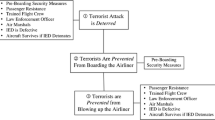Abstract
TSA PreCheck is the primary vehicle used by the Transportation Security Administration (TSA) to promulgate its risk-based security strategy. To enroll in PreCheck requires travelers to pay a fee of $85 (or more, through programs like Global Entry or Nexus), which may provide an obstacle for some travelers. The TSA has promoted TSA PreCheck since it makes the air system more secure, provides faster security screening throughput for all travelers, and reduces TSA screening costs (both in manpower and equipment). This third point has led critics of the program to suggest that PreCheck should be offered at no cost to travelers. This paper explores this suggestion and suggests that for certain high volume travelers, offering them TSA PreCheck at no cost is economically attractive to the TSA. The additional benefits of a more secure air system and faster security screening throughput makes the no-cost option a viable strategy for ramping up the number of high volume travelers enrolled in TSA PreCheck.
Similar content being viewed by others
References
Transportation Security Administration (2016) TSA’s 2017 Budget – A Commitment to Security (Part I), Available at https://www.tsa.gov/news/testimony/2016/03/01/hearing-fy17-budget-request-transportation-security-administration, retrieved 16 June 2016
US Department of Transportation (2016) Bureau of transportation Statistics: Passengers, http://www.transtats.bts.gov/Data_Elements.aspx?Data=1, retrieved 16 June 2016
Acknowledgements
This research was supported in part by the National Science Foundation (DMI-0900226) Any opinions, findings, and conclusions or recommendations expressed in this material are those of the authors and do not necessarily reflect the views of the National Science Foundation.
Author information
Authors and Affiliations
Corresponding author
Appendix
Appendix
Data from Transportation Security Administration (2016) and US Department of Transportation (2016):
- A1:
-
TSA Annual Personnel Cost (= $3B)
- A2:
-
TSA Annual Equipment Cost (= $200M)
- B:
-
TSA Field Officers (= 42,848)
- E:
-
Number of enplanements in 2014 (= 900M)
- F:
-
Annual Number of Screenings Conducted by the TSA (= 650M)
- K1:
-
Current Number of PreCheck Enrolled (= 2 M)
- K2:
-
Targeted Number of PreCheck Enrolled (= 10M, 15M, 20M, 25M)
- L:
-
Average Annual Number of Screens per PreCheck Traveler (= 6, 12, 18, 24)
- D:
-
Cost per Screening for TSA Field Officers
- C1:
-
Base Cost per Screening for TSA Field Officers
- C2:
-
Non-base Cost per Screening for TSA Field Officers (with the current number of PreCheck enrolled)
- α:
-
Ratio of Non-base Screening Cost for Enhanced Screening Versus Expedited Screening for One Traveler (= 2,3,4,5,6) (Both TSA Field Officers and Equipment)
Using this input data, the following annual values are computed:
For the current number of PreCheck travelers (K1) averaging L screens per year,
- G1:
-
Non-base Cost per Enhanced Screening for TSA Field Officers = \( \left(\frac{\mathrm{F}}{\mathrm{K}1\times \mathrm{L}+\upalpha \times \left(\mathrm{F}\hbox{-} \mathrm{K}1\times \mathrm{L}\right)}\right)\times \mathrm{C}2\times \upalpha \)
- G2:
-
Non-base Cost per Expedited Screening for TSA Field Officers = \( \frac{\mathrm{G}1}{\upalpha} \)
For the projected number of PreCheck travelers (K2), averaging L annual screens,
- G3:
-
Non-base Cost per Screening for TSA Field Officers = \( \left(\frac{1}{\mathrm{F}}\right)\times \left(\left(\mathrm{F}\hbox{-} \mathrm{K}2\times \mathrm{L}\right)\times \mathrm{G}1+\left(\mathrm{K}2\times \mathrm{L}\right)\times \mathrm{G}2\right) \)
- J1:
-
Equipment cost per screening = A2/F
- J2:
-
Equipment cost per Enhanced Screening = \( \left(\frac{\mathrm{F}}{\mathrm{K}1\times \mathrm{L}+\upalpha \times \left(\mathrm{F}\hbox{-} \mathrm{K}1\times \mathrm{L}\right)}\right)\times \mathrm{J}1\times \upalpha \)
- J3:
-
Equipment cost per Expedited Screening = \( \frac{\mathrm{J}2}{\upalpha} \)
- H1:
-
Equipment Cost for Enhanced Screening = \( \left(\frac{a}{a+1}\right)\times \mathrm{J}1 \)
- H2:
-
Equipment Cost for Enhanced Screening = \( \left(\frac{a}{a+1}\right)\times \mathrm{J}1 \)
- S1:
-
Personnel cost savings = C2 × F − ((F − K2 × L) × G1 + K2 × L × G2)
- S2:
-
Equipment cost savings = A2 − ((F − K2 × L) × J2 + K2 × L × J3)
- S:
-
Total cost savings = S1 + S2
Rights and permissions
About this article
Cite this article
Jacobson, S.H., Khatibi, A. & Yu, G. When should TSA PreCheck be offered at no cost to travelers?. J Transp Secur 10, 23–29 (2017). https://doi.org/10.1007/s12198-016-0176-z
Received:
Accepted:
Published:
Issue Date:
DOI: https://doi.org/10.1007/s12198-016-0176-z




